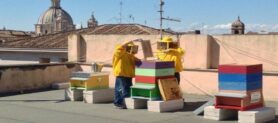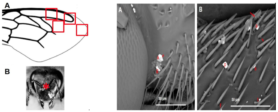Air bee and bee: The unexpected power of hosting bees on the next roof.
Air bee and bee: The unexpected power of hosting bees on the next roof.
Written by: Mario Orrico
In recent years, urban beekeeping has become a widespread practice in major cities around the world. Between 1999 and 2012, London saw a 220% increase in beekeepers and dutch cities are experiencing an increase in bee-oriented activities. But do bees even thrive in these urban environments? And why do cities want to breed these stinging creatures?
Maybe you have noticed mini-gardens full of flowers above the stops while waiting for your bus to Utrecht. Or maybe you have seen small colorful boxes attended by alien figures wrapped in protective netting working next to your house. In the Netherlands, the decline of bees is being tackled with initiatives to preserve both bees and the biodiversity of the urban environment. Honey bees, in fact, are highly adaptable insects and do not need lush meadows and unspoiled nature to thrive. Also, their daily flight allows the exploration of consistently large areas. This enables them to acquire enough nectar to live and reproduce.
But what’s in it for the cities? Recent studies from the School of Agriculture and Environment, University of Western Australia, showed that having beehives in the cities gives significant advantages in terms of plant biodiversity, local economy, and environmental quality. Bees are in continuous contact with the air. So, while they are buzzing around, casually pollinating plants and flowers, they also collect air-residuals. Researchers can therefore use urban honey bees to check the quality of the local air. How cool is that! There are projects of urban beekeeping in several cities worldwide like Rome, Paris, Boston, Mallorca, Edinburgh, London.
Urban beekeeping in action
At first glance, Rome has little in common with Utrecht, because of the higher urban density and fewer green spaces. It looks like an impossible environment for bees to thrive in. However, Apincittà, literally, “bees in the city”, is a unique project developed by a collaboration between the Italian beekeepers’ association and the Italian Army. Thanks to this project, the laboratories of the army are assessing the pollution levels of the city using honey bees as “natural sentinels”. Monitoring more than 16 beehives located in different districts, samples are regularly tested to quantify the effect of traffic and industrial activities on the air that citizens breathe.

Figure 1 – Beekeepers over the roofs of Rome with the project Apincittà. Carabinieri Site.
“Even if there are no standardized procedures for environmental monitoring through honey bees, there are several indicators of contamination that could be assessed,” said the Head of the Beekeeping Operational Unit at the Experimental Institute of the Lazio and Tuscany Regions, dr. Giovanni Formato. Particular matter, radionuclides, aromatic polycyclic hydrocarbons, and pesticide residuals are some of them. Moreover, the water and the pollen transported by these insects could be used to assess the quality of water and the presence of toxic substances (i.e. alkaloids) in the plants over the city. By analyzing at different times the wings, body-hair, and legs of these animals, it is possible to have a complete and dynamic description of the urban ecosystem characteristics.

Figure 2 – Place of sampling for particular matter on the honey bees (wings – head) and detail of SME scanning. (Pellecchia & Negri, 2018)
Holy flight and environment quality
In addition, the expert says, the peculiar characteristic of flight limited to 3 km, can help to map the quality of the environment and can support city administrators to strengthen anti-pollution regulations in a very specific area. This result is obtained without resorting to technologically advanced and expensive air analyzer methods! What powerful allies these insects can bee! The sacrifice of a few bees (collected alive and frozen) in the name of science is scarcely noticed in colonies of over 40.000 insects. Furthermore, the produced honey and the collected pollen can be used to describe the biodiversity present in an urban area and to evaluate the effectiveness of green measures applied.
Only a few limitations, e.g. the winter period inactivity and the conflicts that the high density of urban honey bees can create to other wild pollinators, are described by Formato. He points out that in all the cities where beekeeping is implemented, it should be clearly regulated. In this way, cities can control the density of beehives and define which procedures should be applied during spring, when bees usually swarm. Currently, no city regulates the maximum concentration of beehives in any given area. A swarming colony in an urban area can cause alarm even though such a swarm is not dangerous. Without a hive to protect bees are not aggressive! However, it is true that small percentages of people are allergic to bee stings, and these people need to take more care when there are more bees around.
Without a doubt, there are numerous benefits in having these creatures buzzing over our roofs. Say a quite ‘thank you” when you see “natural drones” flying over your head while waiting your bus. Supporting your neighbor urban beekeeper could be not only a question of sweetness!

